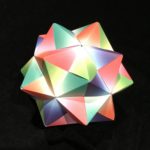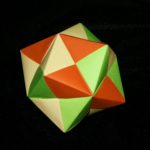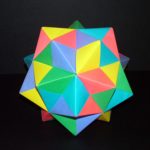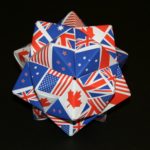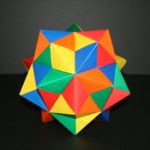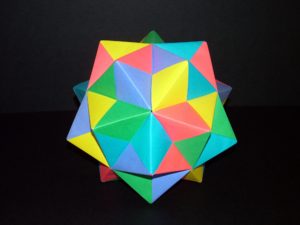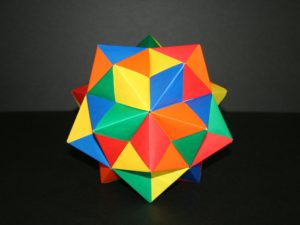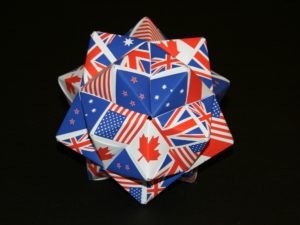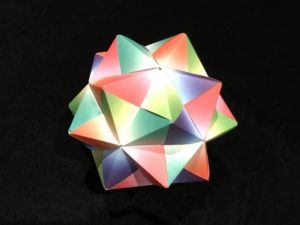The classic origami ball is made from 30 sheets of paper each folded into a ‘Sonobe’ unit and then slotted together. It supposedly has a long history as (for instance) an emblem of good luck at weddings, though I’ve found little on the web to confirm this.
I discovered a couple of these balls at a friend’s wedding (one of the couple is Japanese), smuggled them out in my pockets, and reverse-engineered them; but along the way I re-designed the pieces to make the model more robust and introduce a bit of maths to the colouring. As a result the version that I teach is not quite Sonobe but is more robust and is usually very pretty.
The basic unit, and the method of assembly, are shown in the Instructions for the Octahedral Ball.
For the full version 30 sheets of paper are used, but there is a simpler (and much quicker) version with 12 sheets. By now some readers, at least, are thinking Icosahedron and Octahedron, so I’ll start with the Octahedral Ball.
Octahedral Ball
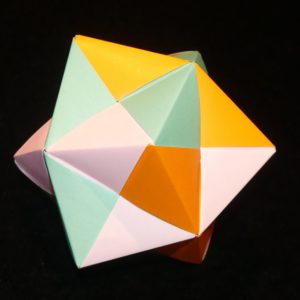 This is a nice project to do in a classroom with children or round a dining table with adults; it typically takes about an hour and a half, with some people ‘getting it’ quickly and others struggling. It works well both with 15cm origami paper and with thin office paper, though thicker paper gets a bit hard to handle. You can do it with ‘note cubes’ from stationery stores, but if you want perfection this paper is usually either too tough or too weak and the resulting balls are a bit small. (But if you’re in a boring meeting at work and it’s the only paper available… well, needs must.)
This is a nice project to do in a classroom with children or round a dining table with adults; it typically takes about an hour and a half, with some people ‘getting it’ quickly and others struggling. It works well both with 15cm origami paper and with thin office paper, though thicker paper gets a bit hard to handle. You can do it with ‘note cubes’ from stationery stores, but if you want perfection this paper is usually either too tough or too weak and the resulting balls are a bit small. (But if you’re in a boring meeting at work and it’s the only paper available… well, needs must.)
People normally manage to fold the parts, though it’s worth insisting that they must be very accurate with their folding. After they’ve done that, they often stumble with putting them together: so if you’re the teacher, be prepared for some stressful moments towards the end of the session. But everyone will be thrilled with the result.
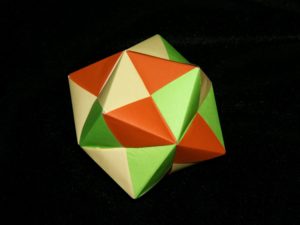 You can colour the ball two ways: as 4 units in 3 colours, or 3 units in 4 colours. These reflect different geometries of the Cube and Octahedron. Neither is ‘right’, but it usually turns out easier to tell people to work in 3 colours with 4 units of each, making sure every pyramid has three colours and every 4-way crossing is a checkerboard.
You can colour the ball two ways: as 4 units in 3 colours, or 3 units in 4 colours. These reflect different geometries of the Cube and Octahedron. Neither is ‘right’, but it usually turns out easier to tell people to work in 3 colours with 4 units of each, making sure every pyramid has three colours and every 4-way crossing is a checkerboard.
The basic unit, and the method of assembly, are shown in the Instructions for the Octahedral Ball.
Icosahedral Ball
A lot more interesting, though also a lot more work, is to use 30 sheets of paper. Again there are two options on the colouring: 5 units in 6 colours, or 6 units in 5 colours. Either will produce a beautiful model, and the choice is often driven by how many colours you have access to. Many packs of paper only give you 5 colours: for choice, though, I’d go for 6 since these create ‘great circle’ bands of colour round the ball and come in pairs of two, relating to the x, y and z axes.
I haven’t written any instructions yet, but obviously if you can handle the Instructions for the Octahedral Ball this is a simple step further on…!
The next step is Origami Boxes.
